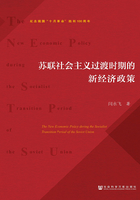
Abstract
The New Economic Policy(NEP)which was practiced by the Communist Party of the Soviet Union(CPSU)in 1920-30s is a political strategy for transition to socialism for the first time in human history. This dissertation systematically explores the successive order and inherent relationship of the tasks, methods and problems of the NEP in different historic periods, i. e. the recovery, improvement and transformation of national economy; and it clarifies the historical thread and theoretical logic of the inner-party struggles of the CPSU with regard to the debates on the NEP.
At the end of 1920 after the civil war, the worker-peasant alliance was in danger of breaking up. Therefore, Lenin proposed that the initial target of the NEP was to consolidate the worker-peasant alliance by achieving the economic integration of industry and agriculture through commerce. Appropriately, two principal policies were implemented: levying agricultural tax and allowing peasants to sell grains freely; entitling industrial enterprises to operate independently owing to adopting economic calculation. Afterwards, the industrial and agricultural products were exchanged in the market. Finally, with the aid of state capitalism, it was possible to realize a rapid national economy recovery.
However, a selling crisis of industrial products broke out as a result of the deterioration of“price scissors”which was caused by the superior trading ability of industry compared with agriculture. Divergence on how to alleviate the crisis existed in the CPSU, which further escalated into the line struggles over the national industrialization. Immediately, the debate came down to how to look at the NEP. Stalin emphasized that industrialization should not depend on the deprivation of peasants, and insisted on the NEP through which the socialist society would be built in an isolated Soviet Union. In contrast, Trotsky placed full credit in the world revolution and repudiated that socialism could be actualized in one country alone. He also required modification or even abolition of the NEP because it could not effectively prevent the restoration of capitalism in the Soviet Union. Consequently, the former won and resulted in an advancement of the national industrialization. In order to improve the national economy, it was necessary to establish a unified planning system, and to restructure the industrial management system. In addition, to accelerate the growth of industry, priority was given to the development of the heavy-industry with the method of accumulating capitals within the industrial sector and appropriating funds from the national budget. Meanwhile, to promote the development of agriculture, the individual economy was stimulated by loosening rural policies further.
Nevertheless, the development of agriculture lagged far behind industry as the growth of small-scale peasant economy soon reached its limit. Together with the low commercialization rate of grain in individual economy, it worsened the situation and a purchasing crisis of grains arose. Leaders' opinions were divided over the solution of the crisis, and this division within CPSU intensified into the line struggles of the agricultural collectivization. Instantly, the argument boiled down to how to deal with the NEP once more. Stalin was in favor of the development of the NEP and stressed that socialist transformation of agriculture can only be achieved by the proletariat leadership over the peasantry; conversely, sticking to the NEP, Bukharin asserted that the worker-peasant alliance was unshakable, and did not believe in increasing agricultural production at the expense of evolution of rural ownership. Eventually, the former triumphed and a campaign of agricultural collectivization was carried out. For the purpose of transformation, it was absolutely essential to guide the entire peasantry to take the socialist road by promoting cooperativization of agricultural production, and to realize productive integration of industry and agriculture through tractor stations and pre-contract system. Furthermore, based on the wholesale collectivization, the kulaks as an exploiting class had been eliminated thoroughly. Finally, both industry and agriculture were built on the foundation of socialized production, and the national economy was drastically transformed into a socialist one.
After the socialist transformation of commerce, industry and agriculture, under the leadership of the proletariat and on the basis of the worker-peasant alliance, the NEP retreated from the stage of history gradually, as its goal of transition to socialism had been achieved.
Key words: New Economic Policy; Transition to Socialism; Worker-peasant Alliance; National Industrialization; Agricultural Collectivization